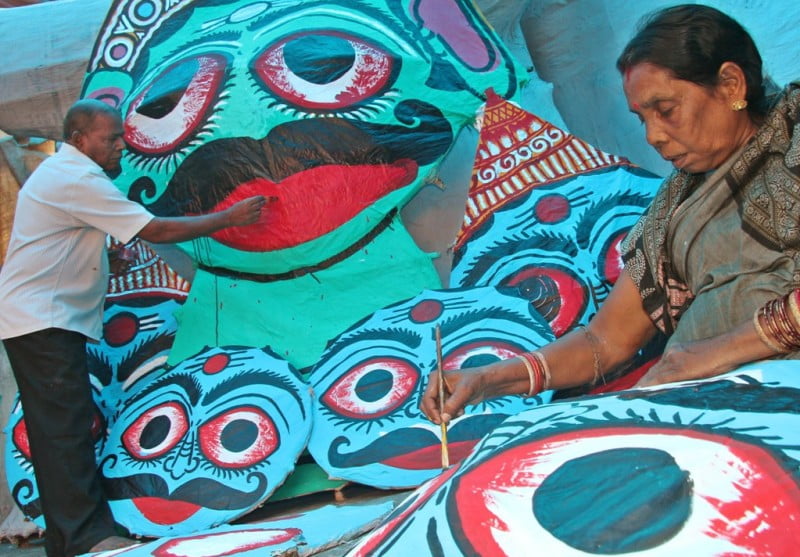Ravana Makes The Celebration Grand For This Family Of Artists In Odisha Capital

Bhubaneswar: Ravana Podi brings a fiery end to Durga Puja celebrations. The victory of good over evil is marked by attractive display of pyrotechnics. Huge effigies of Ravana are set afire amid colourful fireworks with crowds cheering.
But creating these huge effigies is no child’s play and Mohapatra household of Old Town in Odisha capital knows it only too well as this family of artist gets down to work a month before Dussehra.
And this has been a routine for Sobharani and her husband Rajkishore for over three decades now.
After shifting to the capital city from a small village in Khurda district, the couple dabbled in Pattachitra and wooden and stone sculptures before they got their first order from Bhimakund Durga Puja Committee for creating an effigy of Ravana.
Those from Damana, Chandrashekharpur, Naharkanta, Baramunda, Jatni, Baragarh, Ganganagar and Bhimtangi now get it done from them. However, demand for the effigies has contracted over the years along with the height of Ravana, which is now more or less confined to 45 feet. “There were times when effigies as tall as 100 feet were created. We did one for the pandal at Nayapalli,” said Sobharani.

Making Of The Demon King
It begins with tying up the bamboo frames, which comprises almost 70 per cent of the total work and takes about 15 days to complete. These huge structures are created using cloth, paper, nails, ropes, gum and colours.
Twenty sarees are required for making one effigy and these they procure from wholesalers at half the cost. The sarees are dipped in the glue and spread over the bamboo frame, five for the body, four for the legs and the rest for the other body parts and shoes.
“Around 5 to 6 kg of white flour is cooked every day for making the glue. It takes about 4 to 5 hours to ready it,” said Sobharani.

Incorporating Changes
Only bamboo and papers were earlier used for making these effigies. “Since papers soak in rain and get spoiled, we shifted to cloths. Papers are now only pasted at the joints of the cloth to give it a smooth finish,” Sobharani said.
Instead of water colours, the family now uses distemper. “We opted for the latter to prevent the colours from getting washed away in the rain,” she added.
There have a few additions and subtractions too. “Shoes and fist to hold the sword have been added to make these look attractive,” said Rajkishore.
The distinctive moustache was once made using jute. “Now, we paint the entire face, body and legs. It is then decorated with glitters, mirrors and zari,” he added.
Cost Factor
While the rising cost of materials forced them to do away with the jute moustache, the effigies of Kumbhakarna and Meghnad too are now missing from the scene with puja committees cutting down the Ravana Podi budget and sticking to only the demon king.
The family spends around Rs 6,000 on an effigy, which is sold for Rs 10,000 to Rs 12,000. “There isn’t much profit in the effigy making, but we enjoy doing it. My house abuzz with activity with my children and grandchildren dropping in to help us. In a way, Ravana makes the festival a grand affair,” said Sobharani.

The D-Day
A day before Dussehra, the effigies are transported in a truck to the pandals. The structure is then fitted on the ground where Ravana Podi is organised.
The family takes pride in its work as all elements of nature witness the fall of the evil and rise of the good.

Comments are closed.